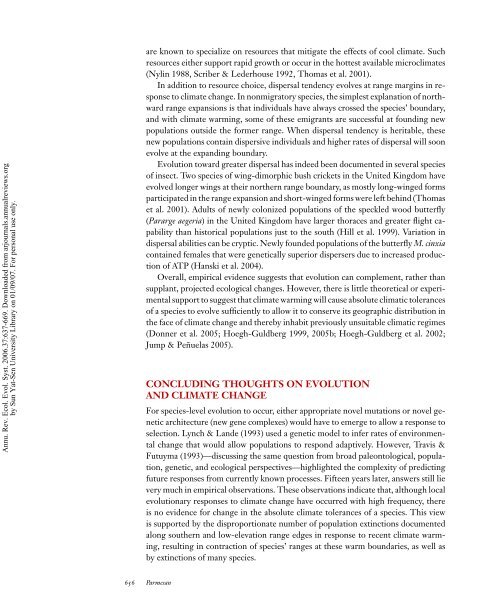Ecological and Evolutionary Responses to Recent Climate Change
Ecological and Evolutionary Responses to Recent Climate Change
Ecological and Evolutionary Responses to Recent Climate Change
Create successful ePaper yourself
Turn your PDF publications into a flip-book with our unique Google optimized e-Paper software.
Annu. Rev. Ecol. Evol. Syst. 2006.37:637-669. Downloaded from arjournals.annualreviews.org<br />
by Sun Yat-Sen University Library on 01/09/07. For personal use only.<br />
are known <strong>to</strong> specialize on resources that mitigate the effects of cool climate. Such<br />
resources either support rapid growth or occur in the hottest available microclimates<br />
(Nylin 1988, Scriber & Lederhouse 1992, Thomas et al. 2001).<br />
In addition <strong>to</strong> resource choice, dispersal tendency evolves at range margins in response<br />
<strong>to</strong> climate change. In nonmigra<strong>to</strong>ry species, the simplest explanation of northward<br />
range expansions is that individuals have always crossed the species’ boundary,<br />
<strong>and</strong> with climate warming, some of these emigrants are successful at founding new<br />
populations outside the former range. When dispersal tendency is heritable, these<br />
new populations contain dispersive individuals <strong>and</strong> higher rates of dispersal will soon<br />
evolve at the exp<strong>and</strong>ing boundary.<br />
Evolution <strong>to</strong>ward greater dispersal has indeed been documented in several species<br />
of insect. Two species of wing-dimorphic bush crickets in the United Kingdom have<br />
evolved longer wings at their northern range boundary, as mostly long-winged forms<br />
participated in the range expansion <strong>and</strong> short-winged forms were left behind (Thomas<br />
et al. 2001). Adults of newly colonized populations of the speckled wood butterfly<br />
(Pararge aegeria) in the United Kingdom have larger thoraces <strong>and</strong> greater flight capability<br />
than his<strong>to</strong>rical populations just <strong>to</strong> the south (Hill et al. 1999). Variation in<br />
dispersal abilities can be cryptic. Newly founded populations of the butterfly M. cinxia<br />
contained females that were genetically superior dispersers due <strong>to</strong> increased production<br />
of ATP (Hanski et al. 2004).<br />
Overall, empirical evidence suggests that evolution can complement, rather than<br />
supplant, projected ecological changes. However, there is little theoretical or experimental<br />
support <strong>to</strong> suggest that climate warming will cause absolute climatic <strong>to</strong>lerances<br />
of a species <strong>to</strong> evolve sufficiently <strong>to</strong> allow it <strong>to</strong> conserve its geographic distribution in<br />
the face of climate change <strong>and</strong> thereby inhabit previously unsuitable climatic regimes<br />
(Donner et al. 2005; Hoegh-Guldberg 1999, 2005b; Hoegh-Guldberg et al. 2002;<br />
Jump & Peñuelas 2005).<br />
CONCLUDING THOUGHTS ON EVOLUTION<br />
AND CLIMATE CHANGE<br />
For species-level evolution <strong>to</strong> occur, either appropriate novel mutations or novel genetic<br />
architecture (new gene complexes) would have <strong>to</strong> emerge <strong>to</strong> allow a response <strong>to</strong><br />
selection. Lynch & L<strong>and</strong>e (1993) used a genetic model <strong>to</strong> infer rates of environmental<br />
change that would allow populations <strong>to</strong> respond adaptively. However, Travis &<br />
Futuyma (1993)—discussing the same question from broad paleon<strong>to</strong>logical, population,<br />
genetic, <strong>and</strong> ecological perspectives—highlighted the complexity of predicting<br />
future responses from currently known processes. Fifteen years later, answers still lie<br />
very much in empirical observations. These observations indicate that, although local<br />
evolutionary responses <strong>to</strong> climate change have occurred with high frequency, there<br />
is no evidence for change in the absolute climate <strong>to</strong>lerances of a species. This view<br />
is supported by the disproportionate number of population extinctions documented<br />
along southern <strong>and</strong> low-elevation range edges in response <strong>to</strong> recent climate warming,<br />
resulting in contraction of species’ ranges at these warm boundaries, as well as<br />
by extinctions of many species.<br />
656 Parmesan
















